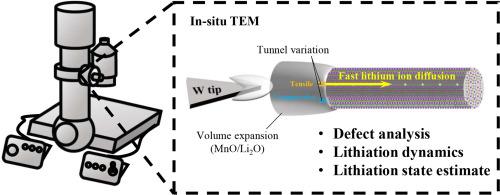Probing the Role of Local Tunnel Variations in Early-Stage Lithiation of α-MnO₂ Nanowires via In Situ TEM
IF 5.6
3区 材料科学
Q1 ELECTROCHEMISTRY
引用次数: 0
Abstract
Understanding lithium-ion transport in tunnel-structured manganese oxides is essential for designing high-performance lithium-ion battery electrode materials. Here, we elucidate the early-stage lithiation mechanism of potassium-stabilized α-MnO2 nanowires using in situ transmission electron microscopy (TEM) coupled with electron energy-loss spectroscopy (EELS), high-resolution TEM (HRTEM), and geometric phase analysis (GPA). Real-time TEM imaging reveals clear volume expansion at the reaction front, while EELS analysis uncovers lithium-ion diffusion far beyond this region, where no visible expansion is observed, indicating fast, defect-assisted transport. GPA and HRTEM analyses show that localized tensile and compressive strain fields, originating from pre-existing local tunnel structural variations, persist after lithiation. The tensile-strained regions enable lithium-ion insertion with minimal lattice distortion, offering additional free volume that facilitates rapid lithium-ion accommodation ahead of the structural transformation. Our results demonstrate a local tunnel variation-mediated fast diffusion pathway that precedes bulk reaction, underscoring the critical role of local strain in enabling early-stage lithium transport. Given the structural versatility of MnO2 and its ability to accommodate diverse atomic arrangements beyond the well-known tunnel phases (β-, γ-, δ-, λ-, R-phases), our findings highlight the importance of understanding and engineering local structural environments. This work provides fundamental insights into the interplay between defects, strain, and ion dynamics, and presents defect engineering as a promising approach to enhance both rate performance and structural stability in manganese-based cathodes.

原位透射电镜研究局部隧道变化在α- mno2纳米线早期锂化中的作用
了解锂离子在隧道结构锰氧化物中的输运对于设计高性能锂离子电池电极材料至关重要。本文利用原位透射电子显微镜(TEM)、电子能量损失谱(EELS)、高分辨率透射电子显微镜(HRTEM)和几何相分析(GPA)阐明了钾稳定α-MnO2纳米线的早期锂化机制。实时透射电镜成像显示反应前沿明显的体积膨胀,而EELS分析发现锂离子扩散远远超出了该区域,在那里没有观察到明显的膨胀,表明快速,缺陷辅助运输。GPA和HRTEM分析表明,局部拉伸和压缩应变场在岩化后持续存在,源于先前存在的局部隧道结构变化。拉伸应变区域使锂离子能够以最小的晶格畸变插入,提供额外的自由体积,有助于在结构转换之前快速容纳锂离子。我们的研究结果表明,局部隧道变化介导的快速扩散途径先于体反应,强调了局部应变在实现早期锂运输中的关键作用。考虑到二氧化锰结构的多功能性及其适应不同原子排列的能力,除了众所周知的隧道相(β-, γ-, δ-, λ-, r -相),我们的研究结果强调了理解和设计局部结构环境的重要性。这项工作为缺陷、应变和离子动力学之间的相互作用提供了基本的见解,并提出了缺陷工程作为提高锰基阴极速率性能和结构稳定性的有前途的方法。
本文章由计算机程序翻译,如有差异,请以英文原文为准。
求助全文
约1分钟内获得全文
求助全文
来源期刊

Electrochimica Acta
工程技术-电化学
CiteScore
11.30
自引率
6.10%
发文量
1634
审稿时长
41 days
期刊介绍:
Electrochimica Acta is an international journal. It is intended for the publication of both original work and reviews in the field of electrochemistry. Electrochemistry should be interpreted to mean any of the research fields covered by the Divisions of the International Society of Electrochemistry listed below, as well as emerging scientific domains covered by ISE New Topics Committee.
 求助内容:
求助内容: 应助结果提醒方式:
应助结果提醒方式:


